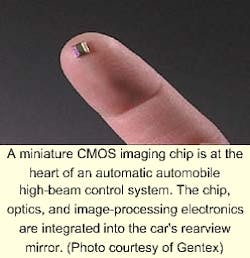
Driving at night on lightly used roads and having to face the headlights of an oncoming car provokes different reactions in different people. Out of fear of annoying the other driver, some never switch on their high beams in the first place. Others decide there is no better place for a game of chicken and keep their own high beams blazing, waiting for capitulation. The most common reaction is a moderate underuse of high beams, resulting in a subtle loss of safety—a US Department of Transportation study found that, on average, drivers use their high beams less than 25% of the time during which conditions justify their use. Automatic high-beam systems have been developed that sense oncoming headlights with a photodiode and then switch the car's beams from high to low, removing the burden of decision from the driver. Unfortunately, these systems also react to streetlights.
Now a headlamp-dimming system developed by Gentex Corp. (Zeeland, MI) relies on a complementary metal oxide semiconductor (CMOS) imaging sensor rather than a single photodiode, and can discriminate between oncoming headlights and other light sources with high accuracy. In addition, the forward-facing system senses taillights up ahead, switching beams from high to low then back to high. The system responds faster than a human can—important when an oncoming car appears quickly over a rise.
The custom-built CMOS sensor was supplied by Photobit (Pasadena, CA), with the primary requirement being a very high sensitivity—enough to detect taillights at a distance of 1500 ft. The sensor uses Photobit's active-pixel photogate technology to meet these specifications. The best location for the headlamp-dimming system is inside the car within the car's rearview mirror, says Joe Stam, an electronics research engineer at Gentex and the inventor of the system. This location is roughly the same as that of the driver, has a view cleared by windshield wipers, and is protected from weather. A low-cost 16-bit microcontroller unit fits within the body of the mirror, while the sensor and inexpensive optics reside in the mirror mount, allowing the mirror position to be adjusted by the driver without changing the orientation of the sensor.
The microcontroller handles the image processing and is connected to the sensor via a specially developed serial interface that does not require a cumbersome ribbon cable. The image processing consists mostly of "blob analysis," where the size, position, centroid, and brightness of various light sources are tracked over time.
The system uses a variety of techniques to distinguish between relevant and irrelevant light sources. Although not full-color, the sensor does have color capability, differentiating between red (to identify taillights) and all other colors. To recognize and exclude streetlights, the system relies on the fact that sodium and mercury-vapor discharge lamps connected to the electricity grid run on 60-Hz alternating current, which produces a 120-Hz flicker. The CMOS sensor's windowing capability—where a subset of pixels can be caused to capture a signal at an increased rate—comes into play here. As described by Stam, the sensor and electronics pick out a light source and zoom in on it with a 3 x 3 pixel window, imaging at 480 frames per second. A Fourier analysis done on the resulting signal looks for a 120-Hz frequency component; if it is present, the light source is deemed irrelevant.
To make the transition from low to high beams and back again more esthetically pleasing, the system slowly fades the high beams on and off. When an oncoming car appears over a hill or around a corner, the system overrides the fade and turns the high beams off instantly. Those night drivers playing high-beam games of dominance can thus turn their energies to some other endeavor—perhaps a calming breathing exercise to erase that last vestige of road rage.
About the Author
John Wallace
Senior Technical Editor (1998-2022)
John Wallace was with Laser Focus World for nearly 25 years, retiring in late June 2022. He obtained a bachelor's degree in mechanical engineering and physics at Rutgers University and a master's in optical engineering at the University of Rochester. Before becoming an editor, John worked as an engineer at RCA, Exxon, Eastman Kodak, and GCA Corporation.
